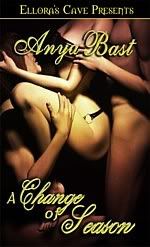Synopsis writing is one of the most distasteful parts of being a writer. I have heard of very few writers who enjoy it. I am definitely not one of those (insane) few. Typically, I write my synopses by repeatedly banging my head against my desk until something breaks free in my brain. So far, it's been an effective technique for me.
Although there are a few other guidelines I follow when synopsis writing:
1. Be a sexy hooker. Find a line that's intriguing, or humorous, something that immediately grabs the reader's attention and makes them want to read on.
2. One paragraph describing the internal conflict for the heroine or hero -- usually the protagonist comes first. In romance the story is about two main characters, but you still have a protagonist. In my books, that's generally the heroine. It's mostly her journey.
3. One paragraph describing the internal conflict for the other main character. Ideally, the internal conflicts of both the h/h should dovetail and grate against each other. (For example, in Blood of an Angel the heroine has a special grievance against vampires and, as luck would have it, the hero is a vampire.) In these two paragraphs explain why this is the worst possible match for both characters.
4. A paragraph describing the external conflict. This is whatever external circumstances are bringing and keeping the h/h together long enough for them to fall in love. The external conflict, ideally, should magnify the internal conflicts.
5. The inciting incident. This is whatever happens that pulls the protagonist and/or main character from his/her ordinary circumstances into the external conflict.
6. Alliance. The characters decide to overlook their differences and work together to resolve a situation, the external conflict.
7. "Holy crap, I'm attracted to you." First intimacy occurs. The heroine and hero discover they're attracted to each other on whatever level -- sexual, emotional, both.
8. "What the hell was I thinking?" When the brief interlude ends and the h/h remember all their fears and internal conflicts
9. The external conflict draws the h/h back together. They must work together to resolve the situation, no matter how they might feel about each other. Of course, they're still attracted to each other. They're falling in love despite the odds.
10. The black moment. Just when you think everything might turn all right, disaster strikes. This could be a result of the external conflict coming to a head, the internal conflict coming to a head, or both.
11. Resolution. When all conflicts are resolved and the h/h find their Happily Ever After (this is must in the romance genre).
Necessary ingredients:
Show the first meeting between the h/h.
Show their first kiss
Include the loves scenes -- especially important in erotic romance
Things you shouldn't do:
Write a synopsis that reads likes a textbook. The synopsis should be written in an engaging manner. The editor has ten zillion partials on their office floor. You've got one chance here. Make the synopsis readable and interesting.
Never leave out the ending or try to hook the editor at the end. They will NOT think it's cute. They will NOT be rushing to request the full to "find out what happens next". The synopsis is not a blurb. It should be a clear outline of the entire book, hitting all the plot points, from beginning to end.
Don't overcomplicate things. Keep it simple. Keep it short.
Happy synopsis writing! (Now there's an oxymoron.)
LMAO!!!












Denise A. Agnew